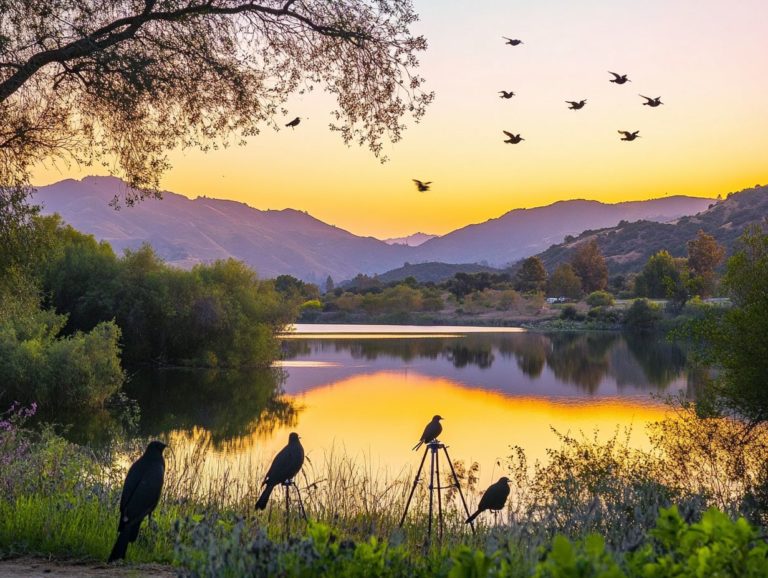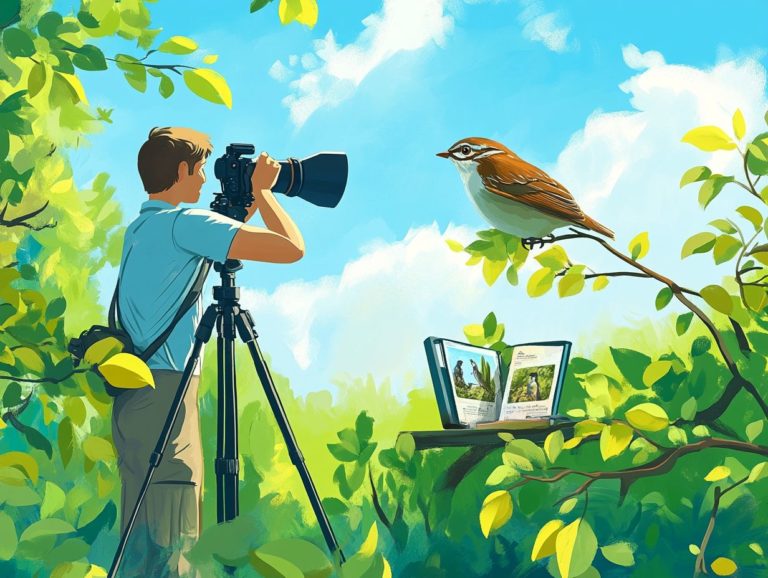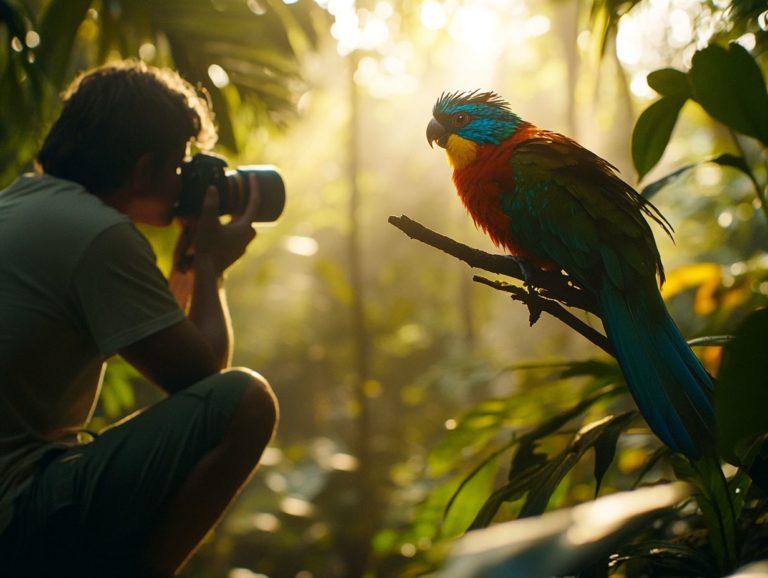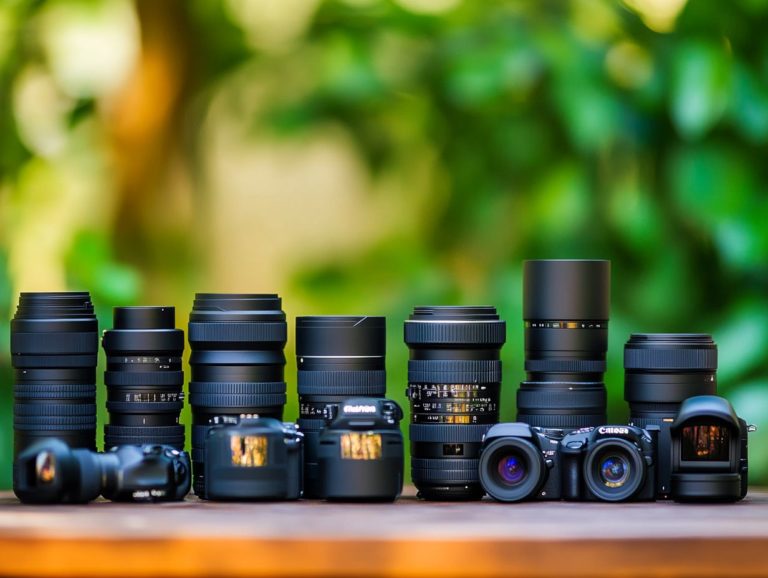The Benefits of Using a Zoom Lens for Birds
Bird photography has a way of enchanting nature enthusiasts. However, capturing breathtaking images of feathered companions can be quite an endeavor, especially for those immersed in wildlife photography.
A zoom lens is indispensable in this pursuit. This article explores the many advantages of using a zoom lens, including built-in teleconverter options, highlighting its versatility and prowess in capturing fast-moving birds from afar.
You will discover the various types of zoom lenses available, essential factors to consider when selecting the right one, practical photography tips for making the most of it, and common pitfalls to sidestep.
Join us on this exciting journey as we explore bird photography!
Contents
- Key Takeaways:
- Advantages of Using a Zoom Lens for Bird Photography
- Types of Zoom Lenses for Bird Photography
- Factors to Consider When Choosing a Zoom Lens
- Tips for Using a Zoom Lens for Bird Photography
- Common Mistakes to Avoid When Using a Zoom Lens for Bird Photography
- Frequently Asked Questions
- What are the benefits of using a zoom lens for birds?
- Will using a zoom lens affect the quality of my bird photographs?
- Are there different types of zoom lenses for bird photography?
- Can a zoom lens help me capture birds in flight?
- Do I need a tripod when using a zoom lens for bird photography?
- What other benefits does a zoom lens offer for bird photography?
Key Takeaways:
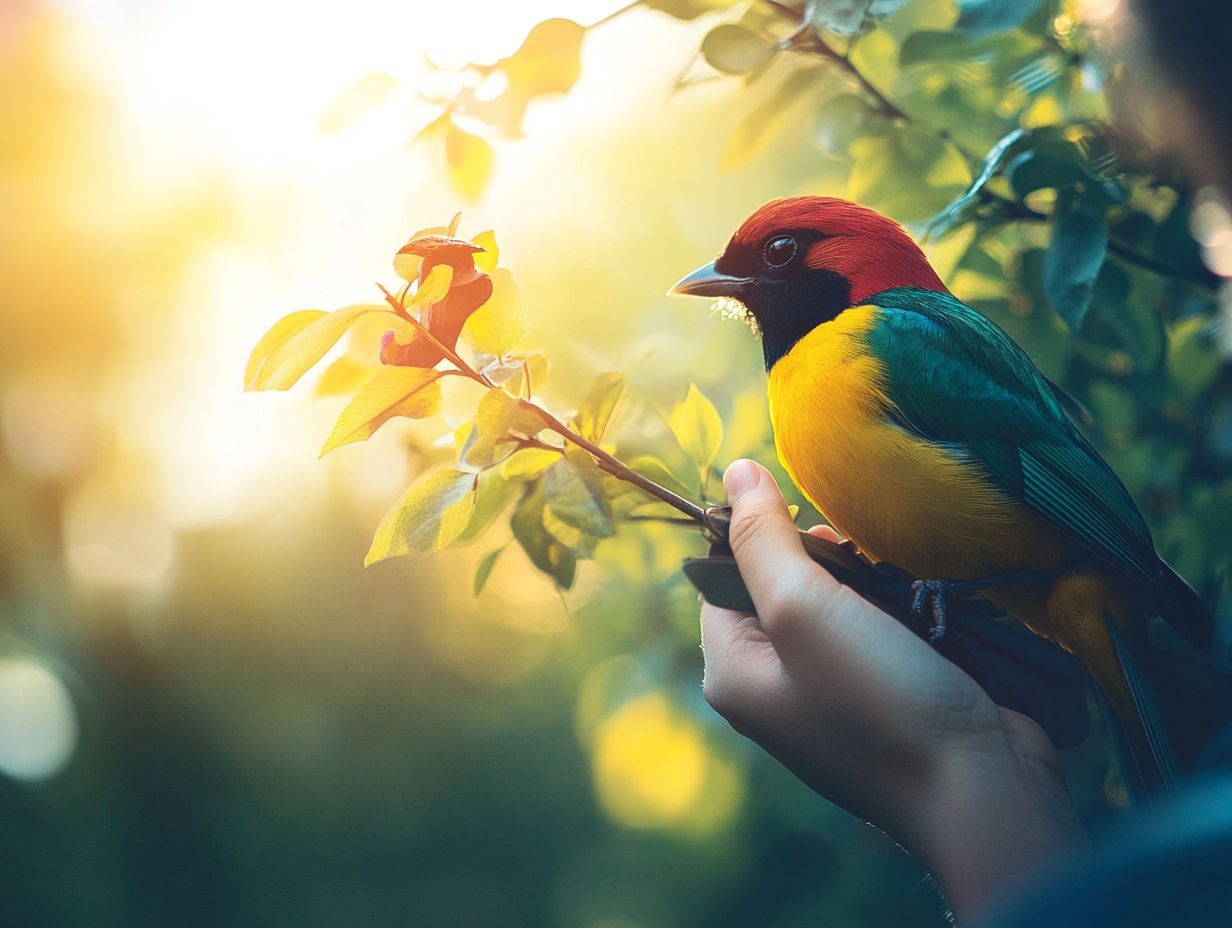
- Zoom lenses give you the freedom to capture a variety of shots without changing lenses!
- Telephoto and super-telephoto zoom lenses are the most popular choices for bird photography, as they provide the necessary magnification to capture distant or fast-moving birds.
- When choosing a zoom lens for bird photography, consider factors such as your budget, lens weight, and overall image quality, including autofocus performance and depth of field.
What is a Zoom Lens?
A zoom lens is your go-to companion in photography, offering the versatility to adjust focal lengths and capture a diverse array of subjects without the hassle of swapping lenses. This flexibility is crucial for wildlife photography, where the ability to make swift adjustments can mean the difference between a spectacular shot of a bird in flight and a sweeping landscape of its natural habitat, especially when using high-quality telephoto lenses.
Zoom lenses come in various configurations, often enhanced with advanced optical elements that elevate image quality to new heights. Unlike prime lenses, which have a fixed focal length, zoom lenses empower you to adapt quickly to changing distances, making them essential during spontaneous wildlife encounters.
The advantages of zoom lenses extend beyond flexibility; they also usually result in a lighter setup, making your journey into nature far more manageable, especially when carrying additional photography equipment.
Take, for example, the Canon EF 100-400mm, a favorite among wildlife photographers for its exceptional performance. It delivers stunning sharpness and smooth zoom mechanics that enhance the shooting experience. Alternatively, the Nikon 200-500mm is celebrated for its remarkable reach, allowing you to capture distant subjects with impressive image quality and beautiful bokeh.
Advantages of Using a Zoom Lens for Bird Photography
Utilizing a zoom lens for bird photography presents you with many advantages, especially in terms of versatility and lens flexibility. This approach enables you to capture breathtaking images of diverse wildlife subjects, including the Great Egret, without the hassle of swapping out multiple lenses.
The capacity to swiftly adjust the focal length becomes essential when encountering fast-moving birds or fluctuating distances. This ensures you never miss a fleeting moment, whether it s a Great Egret soaring through the sky or a songbird perched quietly on a branch.
Grab your camera and zoom lens, and head out to capture stunning bird photos today!
Increased Versatility and Flexibility
One of the key benefits of using a zoom lens for bird photography is the remarkable versatility and flexibility it offers you. This enables you to explore various lens recommendations tailored to your needs. It allows you to adapt to a variety of shooting scenarios without the inconvenience of constantly switching lenses or worrying about the limitations of prime vs zoom configurations.
With this capability, you can effortlessly transition between different focal lengths. This ensures you capture those close-up moments of birds just when they happen, whether you re using a Nikon telephoto lens, a Canon mirrorless system, or even a Sony mirrorless option.
The ability to zoom in and out gives you the power to swiftly adjust your framing. Whether you’re tracking a majestic eagle soaring overhead or capturing a tiny hummingbird delicately feeding on nectar, you enhance your wildlife subjects’ presentation.
With a range of focal lengths at your disposal, you can create stunning wide-angle shots that showcase the breathtaking landscape surrounding a nesting site. You can also zoom in for intimate glimpses of avian behavior that highlight their natural habitats.
Popular models like the Canon EF 100-400mm f/4.5-5.6L IS II or the Nikon AF-S 200-500mm f/5.6E ED VR or even Sigma alternatives are well-regarded for their exceptional sharpness and performance across various lighting conditions. They make excellent choices for anyone eager to elevate their bird photography to new heights.
Ability to Capture Distant or Fast-Moving Birds
The ability to capture distant or fast-moving birds is a remarkable advantage when you use a zoom lens. This is especially true for photographing elusive or quick species like raptors in flight or shorebirds darting along the beach. It enhances your photographic experiences in places like Africa or the Masai Mara.
With the right zoom lens, equipped with better stabilization, a reliable autofocus system, and the option of a teleconverter, you can achieve sharp, high-quality images even in challenging conditions. This technology elevates your shooting experience.
You can focus on the intricate details of a bird’s plumage or the dynamic motion of its flight. You won t be sidetracked by external factors like wind, low light, or lighting changes.
Take, for example, lenses such as the Canon EF 100-400mm f/4.5-5.6L IS II USM, Canon L-series, and the Nikon AF-S NIKKOR 200-500mm f/5.6E ED VR. These lenses are specifically designed to transform your bird photography experience. They boast stellar tracking capabilities that allow you to effortlessly keep pace with active subjects.
As a result, these tools enhance the quality of your wildlife photography. They give you the power to capture fleeting moments that might otherwise slip away. Don’t miss the chance to include every shot in your photography portfolio!
Types of Zoom Lenses for Bird Photography
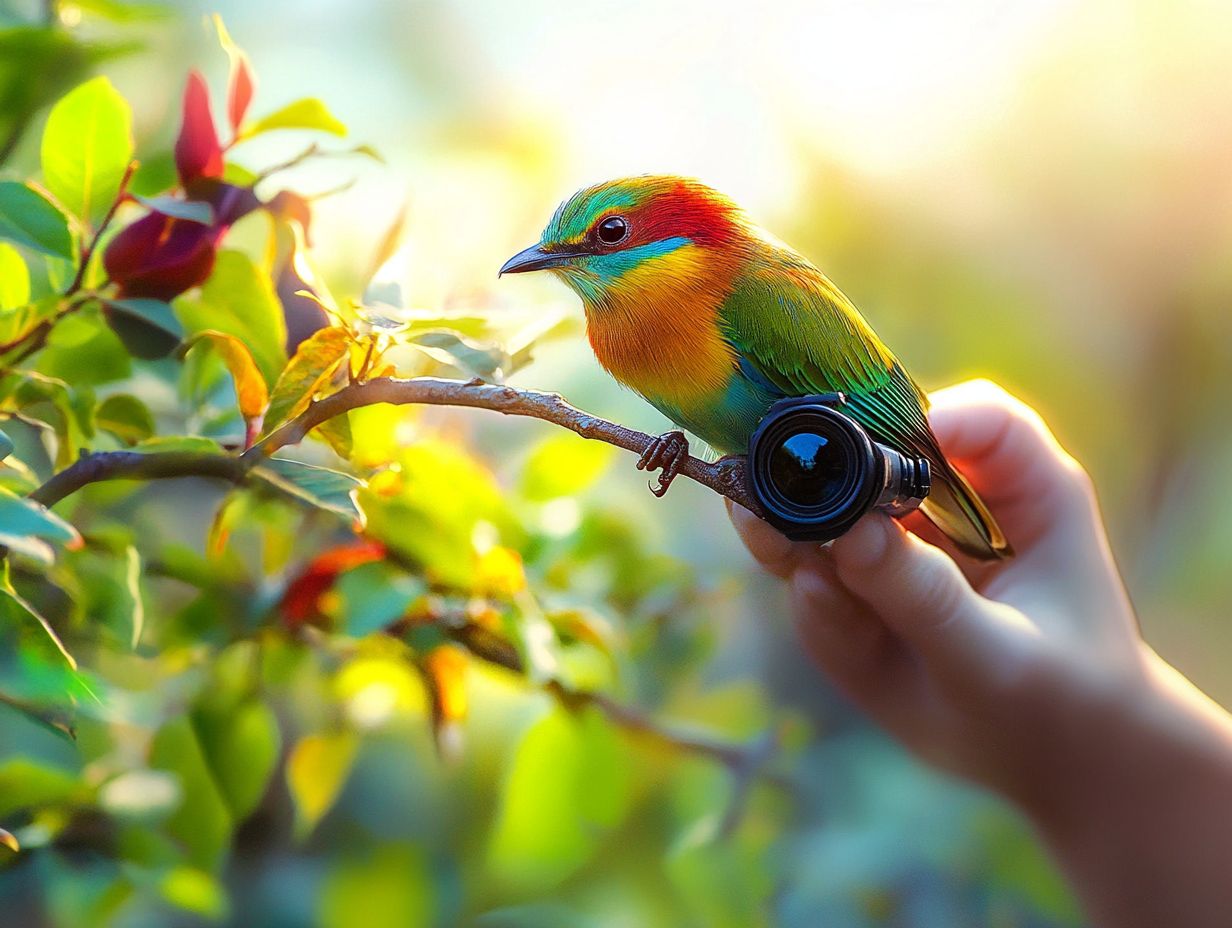
In the realm of bird photography, the variety of zoom lenses and prime lenses available can profoundly influence your shooting experience and lens choice. You have options that span from standard zoom lenses and budget lenses to specialized telephoto and super-telephoto lenses, each crafted for exceptional performance and image quality.
By understanding these distinctions, you can make an informed choice about the right tool for your unique needs. Whether you’re looking for a compact lens perfect for travel or a robust 400mm lens tailored for capturing the nuances of distant wildlife, the right lens can make all the difference.
Telephoto vs. Super-telephoto Lenses
Choosing between telephoto and super-telephoto lenses is an important choice for wildlife photographers like you. Your goal is to capture exquisite images of birds in their natural habitats across diverse environments, including Africa. Telephoto lenses typically cover a focal length range of 70-300mm. They offer versatility for various wildlife subjects and allow for different shooting techniques.
In contrast, super-telephoto lenses range from 300mm to 600mm or more. They give you the extended reach needed to photograph distant wildlife without causing disruption, making them essential for serious wildlife photography.
Your choice will largely depend on your specific shooting conditions, desired outcomes, and the photography course you’ve taken to enhance your skills. For instance, a telephoto lens is ideal when birds are relatively close. This setup allows you greater flexibility and lighter gear, perfect for those long hikes into nature.
Conversely, a super-telephoto lens becomes critical in open fields or wetlands, where birds are further away. This enables you to capture stunning detail without extensive cropping or loss of image quality.
Professionals often prefer higher-end optical options like the Canon EF 100-400mm for their telephoto needs. Enthusiasts might consider something like the Nikon AF-S 200-500mm or Tamron for super-telephoto work. Both options provide impressive performance across various lighting conditions, enhancing low-light photography capabilities and ensuring you get the most out of every shot.
Factors to Consider When Choosing a Zoom Lens
When selecting a zoom lens for wildlife photography, you need to consider several key factors: your budget, desired image quality, and the overall performance of the lens, including its autofocus system. Autofocus is a camera feature that automatically adjusts the lens to ensure the subject is in focus.
With a wide array of options ranging from entry-level budget lenses to premium professional-grade models, understanding these elements will empower you to make an informed decision that elevates your photography portfolio.
Budget, Weight, and Image Quality
Selecting a zoom lens for bird photography requires finding the perfect balance between your budget and the image quality and performance you desire. These elements significantly shape your overall shooting experience, especially when considering lens characteristics and their impact on your final image.
While commendable budget lenses can deliver solid results, investing in a higher-quality lens often enhances optical quality, autofocus efficiency, and low-light capabilities. This contributes to better overall performance.
Budget-friendly options might come with their own set of trade-offs typically, they re heavier or limit your creative potential with fewer features. It s crucial for you to thoughtfully weigh these factors when selecting the right equipment for your photography journey.
If you re just starting out, lenses like the Tamron 18-200mm or Sigma 100-400mm can deliver impressive performance without straining your finances. For those more serious about wildlife photography, higher-end choices like Canon L-series, Nikon s Nikkor lenses, or Sony options stand out. They offer exceptional sharpness and faster focusing, but they do require a more significant investment.
Ultimately, your decision should hinge on your specific needs. Careful assessment of how each factor aligns with your photography goals is essential.
Tips for Using a Zoom Lens for Bird Photography
To unlock your zoom lens s potential, use targeted strategies. Adjust settings based on light and refine your composition techniques. These insights can profoundly impact the quality of your photography portfolio.
Don t wait too long to invest in the right lens; the perfect shot is just around the corner! Start your photography journey today with a lens that meets your needs.
Techniques for Maximizing Zoom Lens Performance
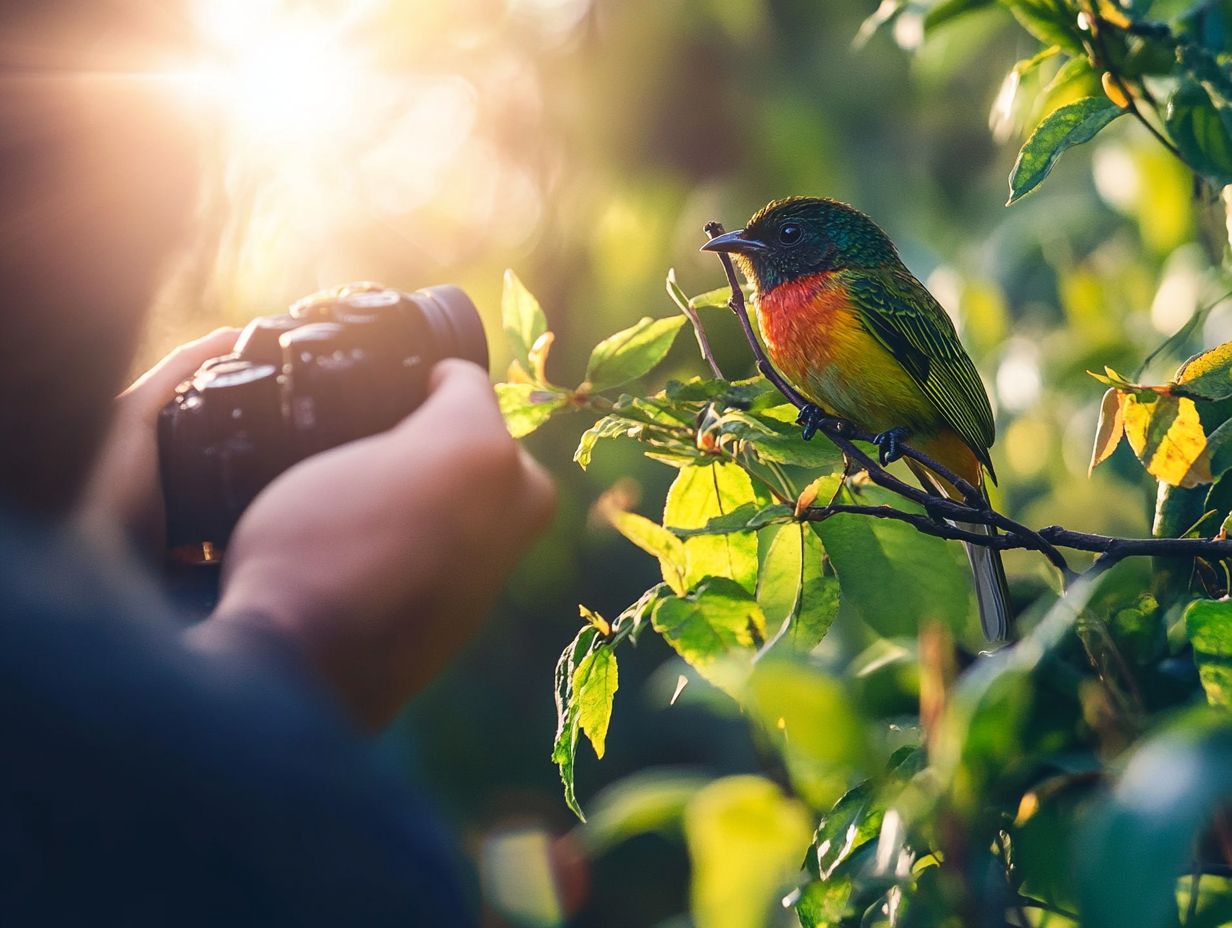
Maximizing the performance of your zoom lens in bird photography is all about blending techniques. Mastering your camera’s autofocus system and selecting the right settings for various wildlife scenarios are key components. Enrolling in a photography course focused on wildlife photographers can equip you with invaluable shooting techniques. This knowledge will boost your chances of capturing breathtaking images of fast-moving or distant birds.
Fine-tuning your exposure settings and focal lengths can dramatically enhance the clarity and brightness of your shots, especially in changing light conditions. Utilizing image stabilization is essential; it helps reduce motion blur that often sneaks in when shooting from a distance or using slower shutter speeds.
Pay attention to your focus settings and depth of field. Experimenting with different apertures to control the quality of the blurry background, often referred to as bokeh, can lead to stunning results. This allows you to capture sharp subjects against beautifully blurred backgrounds. These approaches elevate the quality of your images and refine your overall photographic skills.
For serious enthusiasts, investing time in dedicated photography courses is an invaluable step toward mastery of various lens types.
Common Mistakes to Avoid When Using a Zoom Lens for Bird Photography
When using a zoom lens for bird photography, avoiding common mistakes can significantly elevate your image quality and overall shooting experience. This allows you to capture sharp, vibrant photos that showcase the optical quality of your wildlife subjects.
Understanding the limitations of focal length and the differences between fixed focal lengths are crucial. Additionally, making the necessary adjustments for low-light conditions and super telephoto lenses can enhance your results. By being mindful of these pitfalls, you can truly enhance the performance of your lens and take your photography to the next level.
Blurry Images and Other Common Issues
Blurry images are a frequent challenge for wildlife photographers using a zoom lens. This often stems from issues like camera shake, problems with image stabilization, improper shutter speed, or inadequate autofocus settings with mirrorless camera systems. Understanding the underlying causes of these problems enables you to take the necessary steps to enhance your lens performance.
When shooting at longer focal lengths, even slight movements can lead to less-than-ideal results. This makes it essential to utilize a tripod or a teleconverter. Effectively engaging image stabilization features found in Canon and Nikon lenses is also important. Selecting the appropriate shutter speed tailored to your zoom range based on your subject’s movement can significantly improve image sharpness. A good rule of thumb is to set your shutter speed to at least match the focal length of your lens.
Fine-tuning your autofocus settings can drastically reduce the chances of blurred shots. Opting for continuous autofocus options improves lens performance for moving subjects. This gives you the power to capture vibrant, detailed images of birds, such as the Great Egret, in their natural habitats.
Frequently Asked Questions
What are the benefits of using a zoom lens for birds?
Using a zoom lens allows you to capture birds from a distance. This minimizes any disturbance to their natural behavior, especially with telephoto lenses.
Will using a zoom lens affect the quality of my bird photographs?
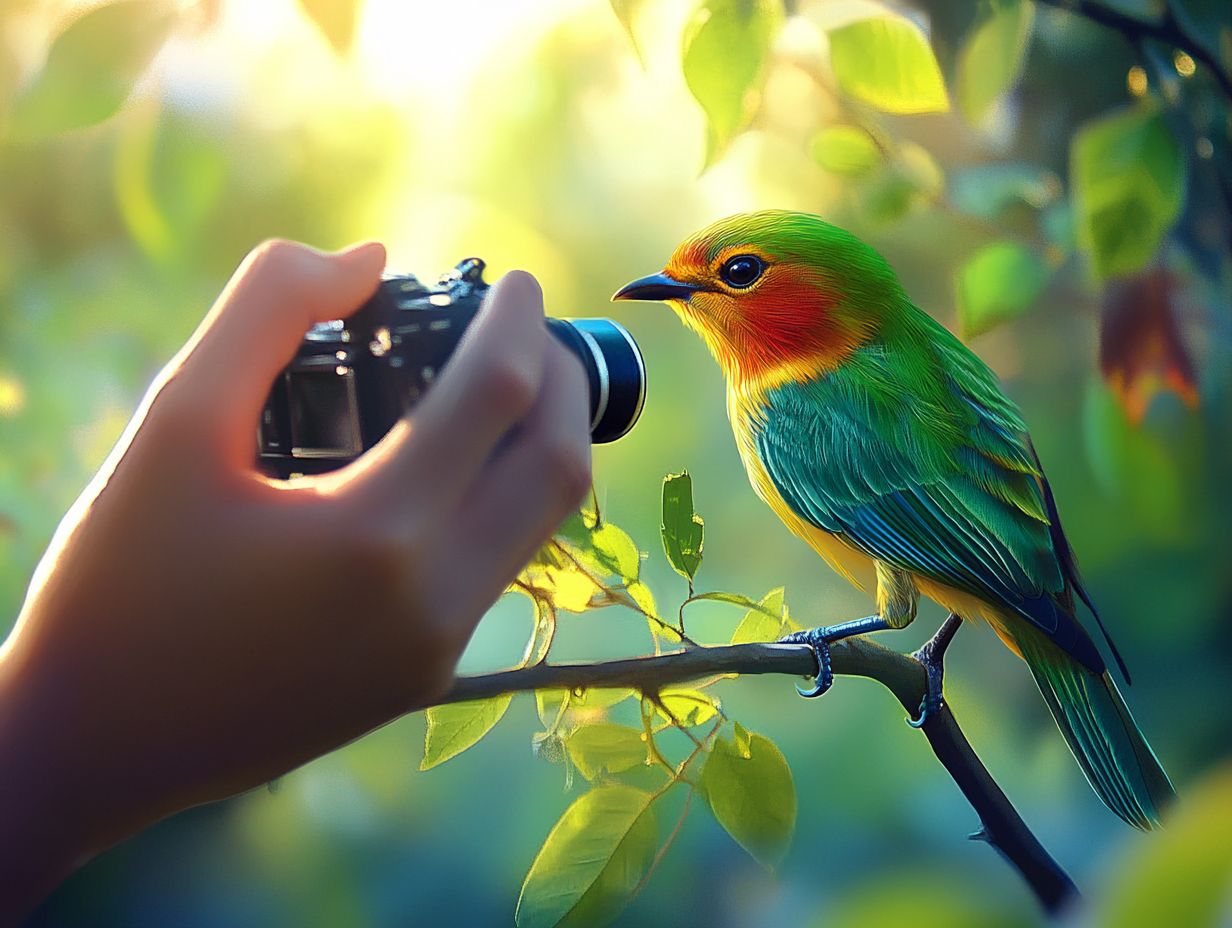
No, in fact, using a zoom lens can improve the quality of your bird photographs. It allows you to get up close and capture details that may not be visible with a standard lens.
Are there different types of zoom lenses for bird photography?
Yes, there are different types of zoom lenses, such as telephoto and super telephoto lenses. Each type has its own benefits for bird photography, including lens flexibility.
In conclusion, mastering your zoom lens and understanding its capabilities can elevate your bird photography. By avoiding common mistakes and utilizing the right techniques, you can capture stunning images that truly showcase the beauty of wildlife.
Can a zoom lens help me capture birds in flight?
Yes! A zoom lens with a fast autofocus feature helps you capture birds in flight with sharp focus. It s essential for stunning close-up photography.
Do I need a tripod when using a zoom lens for bird photography?
A tripod can be helpful, but it s not always necessary. Many zoom lenses have built-in image stabilization to reduce camera shake.
What other benefits does a zoom lens offer for bird photography?
A zoom lens opens up a world of possibilities for capturing various bird species in different environments. You can easily adjust the focal length for creative compositions!


